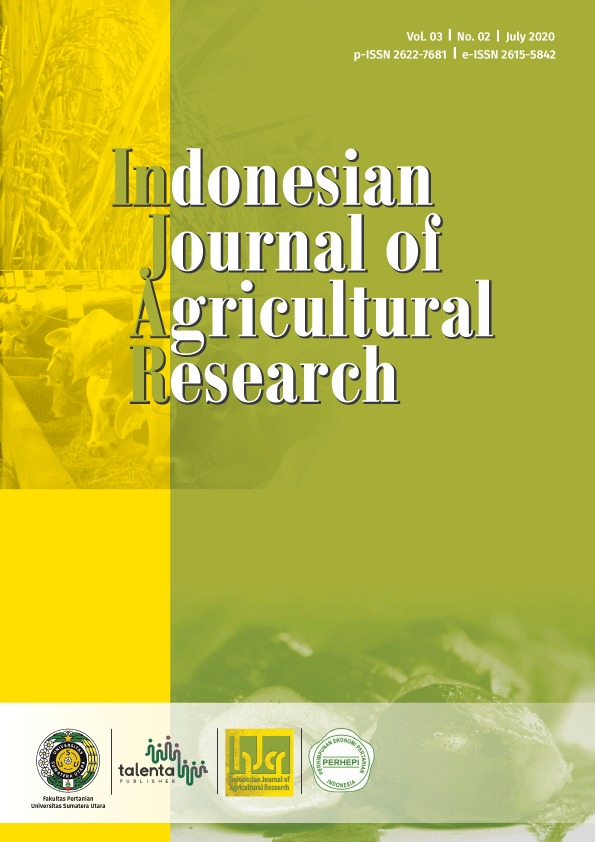Diversity Index of Insect Species on Sorghum Plantations in Kolam Village, Percut Sei Tuan District, Deli Serdang
DOI:
https://doi.org/10.32734/injar.v3i2.3865Keywords:
diversity, function status, insect, richness, sorghumAbstract
This research aimed to know the diversity of insects of sorghum plantations and the status of insect functions in sorghum plants. The purposive sampling method were done, which used 4 traps, consist of yellow sticky trap, sweep net, pitfall trap and light trap for 8 observations research were done from May to September 2019 at Kolam Village, Percut Sei Tuan District of Deli Serdang Regency, then continue to identified in Pest Laboratory Faculty of Agriculture University of Sumatera Utara, Medan. The results showed that there were 117 individuals insects which consist of 10 orders and 33 families. The highest relative density was 14.74% and the lowest was 0.42% sere recorded, while the highest relative frequency was 4.08% and the lowest was 1.53%. The value of insect diversity index was 3.115 (High), it is mean the diversities of insects varied and the habitat was good for growth of insects. The value of evenness index was 0.891 (high) and richness index was 4.15 (high). The dominant insects recorded from Order of Hymenoptera (Family of Formicidae), continued to Coleoptera (Family of Scarabaeidae; Coccinellidae) are quite diverse in the sorghum plantations. The function status of insects was recorded as herbivores, parasitoids, predators, pollinators and decomposer were determined.
Downloads
References
N. Siregar and T. Irmansyah, “Pertumbuhan dan Produksi Sorgum Manis (Sorghum bicolor (L.) Moench) Terhadap Pemberian Mulsa dan Bahan Organik: The Growth and Yield of Sweet Sorghum (Sorghum bicolor (L.) Moench) On The Mulch Treatments and Organic Matter,†J. Online Agroekoteknologi, vol. 4, no. 3, pp. 2188–2195, 2016.
M. P. Sirappa, “Prospek pengembangan sorgum di Indonesia sebagai komoditas alternatif untuk pangan, pakan, dan industri,†J. Litbang Pertan., vol. 22, no. 4, pp. 133–140, 2003.
F. X. Wagiman, Hama Pascapanen dan Pengelolaannya. UGM PRESS, 2019.
P. W. Price, Insect ecology. John Wiley & Sons, 1997.
G. L. Purba, M. Marheini, and S. Oemry, “Interaksi trofik jenis serangga di atas permukaan tanah dan permukaan tanah beberapa pertanaman varietas jagung (Zea mays Linn.),†J. Agroekoteknologi Univ. Sumatera Utara, vol. 3, no. 3, p. 104901, 2015.
A. Saragih, “Indeks Keragaman Jenis Serangga Pada Tanaman Stroberi (Fragaria Sp) Di Lapangan,†Universitas Sumatera Utara, 2008.
M. S. Sianipar, L. Djaya, E. Santosa, R. C. H. Soesilohadi, W. D. Natawigena, and M. P. Bangun, “Indeks Keragaman Serangga Hama Pada Tanaman Padi (Oryza sativa L.) Di Lahan Persawahan Padi Dataran Tinggi Desa Sukawening, Kecamatan Ciwidey, Kabupaten Bandung,†Bioma Berk. Ilm. Biol., vol. 17, no. 1, pp. 9–15, 2015.
K. J. Cho, “Ryoo, and SY Kim. 1988. Life table statistic of rice weevil (Coleoptera: Curculionodae) in relation to the presence of rough, brown and polished rice,†Korean. Entomol, vol. 18, pp. 1–16.
D. T. Tambunan, D. Bakti, and F. Zahara, “Keanekaragaman Arthropoda Pada Tanaman Jagung Transgenik,†J. Agroekoteknologi Univ. Sumatera Utara, vol. 1, no. 3, p. 95369, 2013.
V. Sidabutar and L. Lubis, “Indeks Keanekaragaman Jenis Serangga pada Fase Vegetatif dan Generatif Tanaman Kedelai (Glycine maxMerill) di Lapangan: Diversity of insects on vegetative and generative phase of soybean (Glycine maxMerill) in the field,†J. Online Agroekoteknologi, vol. 5, no. 2, pp. 474–483, 2017.
H. Davies and C. A. Butler, Do butterflies bite?: Fascinating answers to questions about butterflies and moths. Rutgers University Press, 2008.
R. I. Depkes, “Entomologi Serangga.†Direktorat Jenderal P2M dan PLP, 1999.
K. Untung, “Pengantar Pengelolaan Hama Terpadu Ed-2.†Yogyakarta: Gadjah Mada University Press, 2006.
O. I. Nyoman, “Pengendalian Hama Terpadu dan Implementasinya di Indonesia.†Gadjah Mada University Press. Yogyakarta, 1995.
A. Mas’ud, “Efektifitas Trap Warna Terhadap Keberadaan Serangga Pada Pertanaman Budidaya Cabai di Kelurahan Sulamadaha Kecamatan P. Ternate,†J. Chem. Inf. Model., vol. 53, p. 159, 2002.
K. M. Heinz, M. P. Parrella, and J. P. Newman, “Time-efficient use of yellow sticky traps in monitoring insect populations,†J. Econ. Entomol., vol. 85, no. 6, pp. 2263–2269, 1992.
Naryanta, “Efektifitas Penangkapan Sticky Trap dengan Variasi Bentuk dan Warna pada Lalat Penggorok Daun Bawang Putih, Liriomyza sp. (Diptera : Agromyzydae).,†UNS Surakarta, 1991.
N. Hariyano, “Inventarisasi Serangga dengan Pit Fall Trap di Kawasan Perkebunan (Ground Insect Inventarisation). http.†2015.
G. R. Tambunan, M. U. Tarigan, and L. Lisnawita, “Indeks Keanekaragaman Jenis Serangga pada Pertanaman Kelapa Sawit (Elaeis guineensis Jacq.) di Kebun Helvetia PT. Perkebunan Nusantara II,†J. Agroekoteknologi Univ. Sumatera Utara, vol. 1, no. 4, p. 95735, 2013.
A. Ismawan, S. E. Rahayu, and A. Dharmawan, “Kelimpahan dan Keanekaragaman Burung di Prevab Taman Nasional Kutai Kalimantan Timur,†J. online UM, vol. 3, no. 1, pp. 18–25, 2015.
D. J. Borror, C. A. Triplehorn, and N. J. Johnson, Pengenalan pelajaran serangga. Gadjah Mada University, 1992.
R. C. Aditama and N. Kurniawan, “Struktur Komunitas Serangga Nokturnal Areal Pertanian Padi Organik pada Musim Penghujan di Kecamatan Lawang, Kabupaten Malang.,†Biotropika J. Trop. Biol., vol. 1, no. 4, pp. 186–190, 2013.
Downloads
Published
How to Cite
Issue
Section
License
Copyright (c) 2020 Indonesian Journal of Agricultural Research

This work is licensed under a Creative Commons Attribution-ShareAlike 4.0 International License.



















